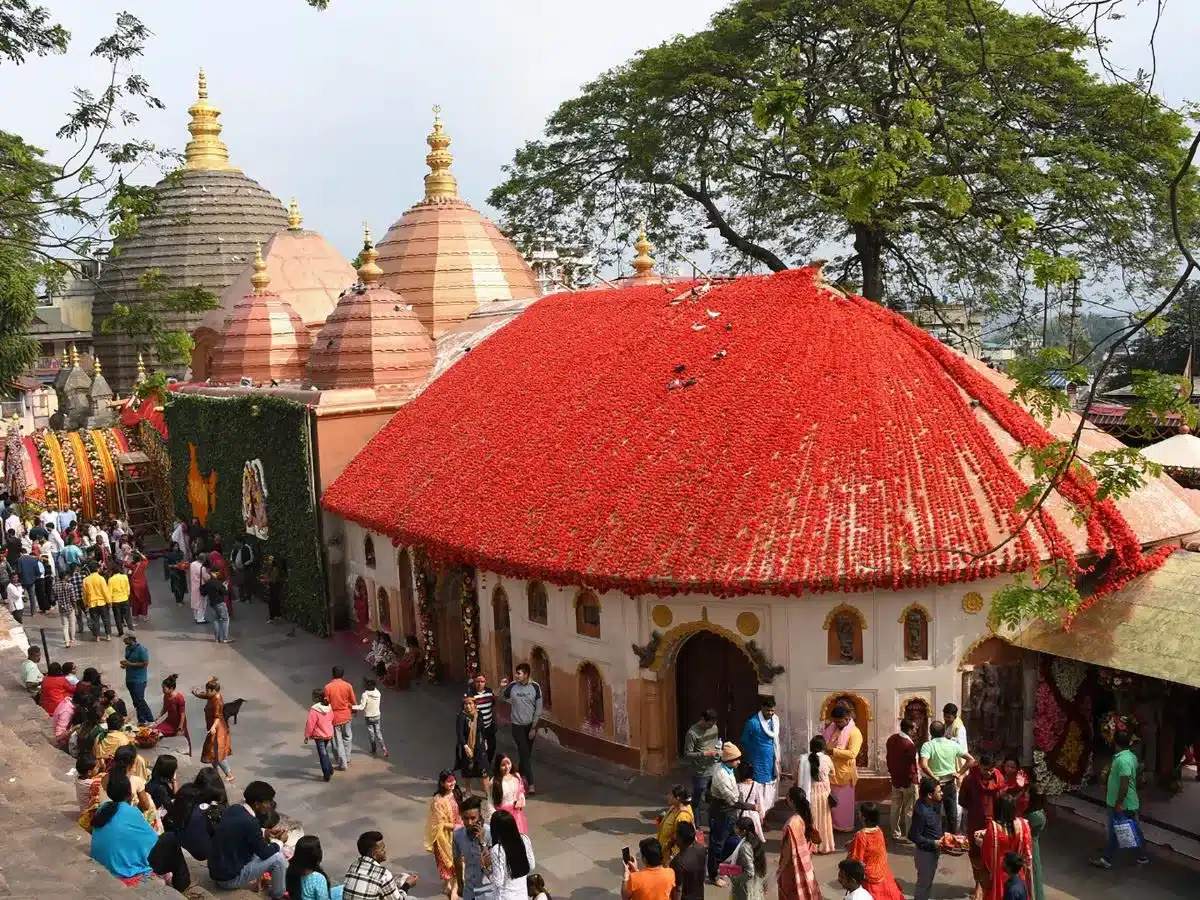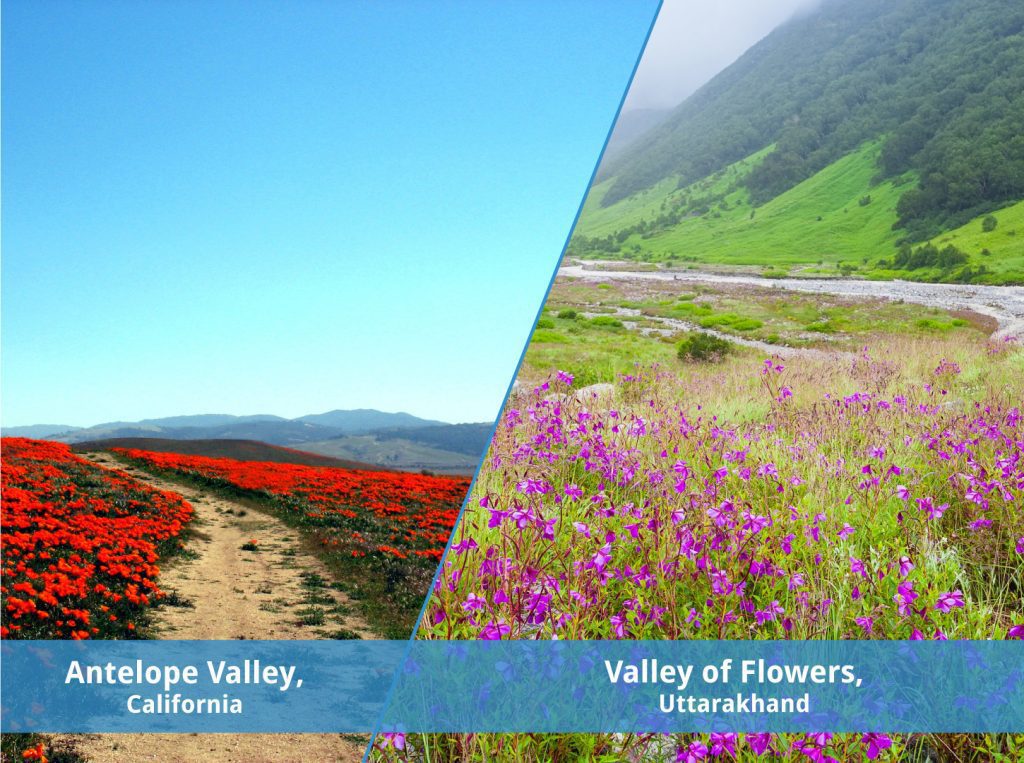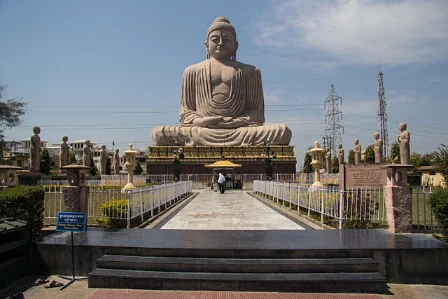Mysore was always a mystery to me. Sure, my dad insists he whisked me away to its grand palaces when I was but a mere infant of six months. Dad always loved to remind me, “You’ve seen Mysore palace before!” But let’s be real, at that age, I was more interested in my toes than architectural wonders. Living in Bangalore, it’s almost embarrassing to admit that Mysore, just a stone’s throw away, remained an unchecked box on my adult travel list.
Then came Dussehra. It was my first time away from home during this beloved festival. As a travel writer, I’ve been fortunate to experience Dussehra festivities from the northern plains to the southern coasts of India. Everywhere, the triumph of good over evil is celebrated with fervor, rituals, and of course, delectable food. It’s my absolute favourite festival. This year, however, I was tethered to Bangalore due to work. But when Dussehra dawned, an idea sparked: Why not visit Mysore? I’d always heard tales of its legendary celebrations.
In Mysore, or as locals fondly call it, Dasara, is not just another festival. While the rest of India revels in the nine nights of Navratri, Mysore transforms into a 10-day spectacle, climaxing on Vijayadashmi or Dasara. In the spirit of being adventurous, I booked a Savaari from Bangalore to Mysore stepped out and decided to explore the city like a local. From its rich history and enduring legacy to the event itinerary, here’s a recount of my journey through this magnificent Mysore Dussehra celebration, along with essential insights for the curious traveller.
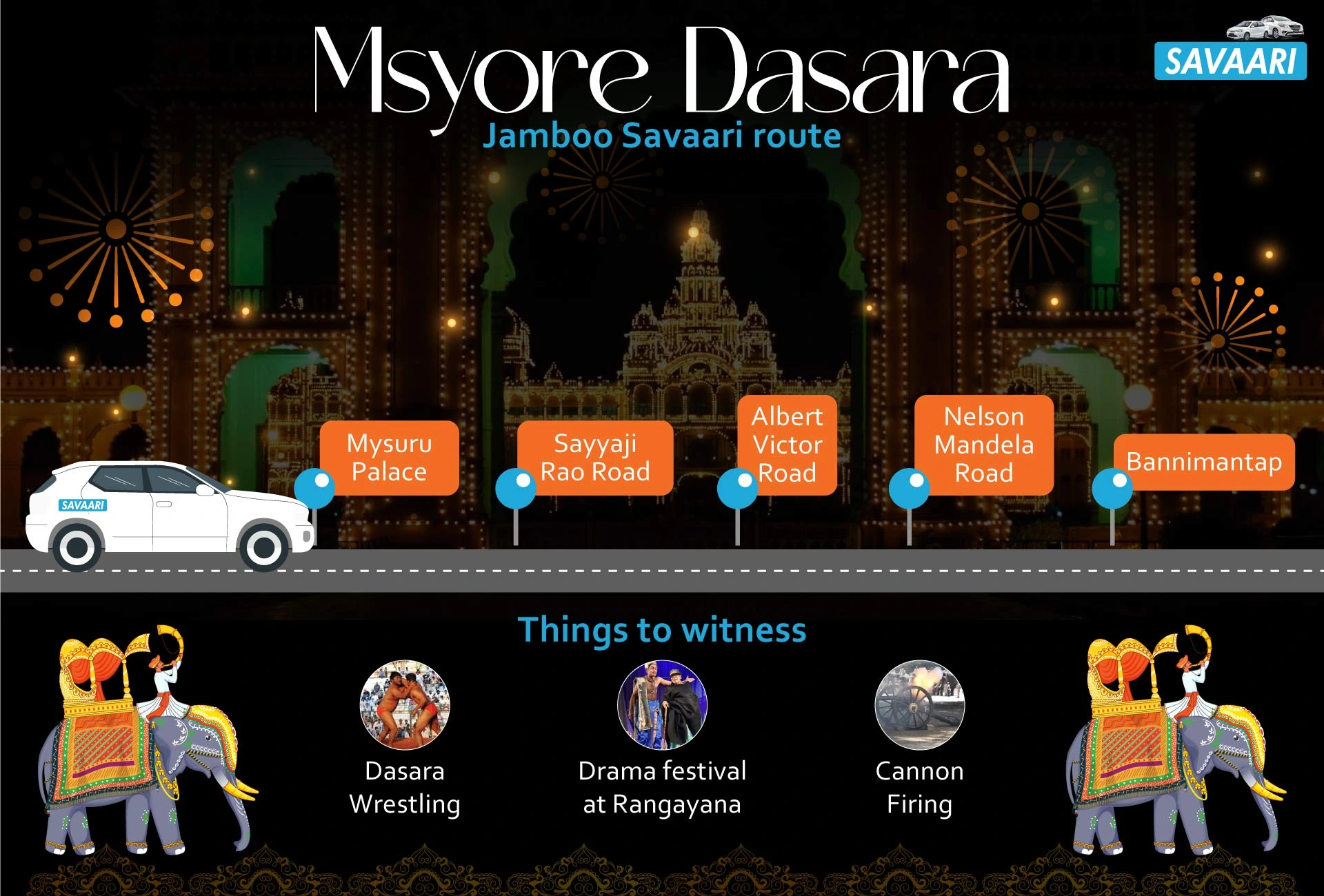
Tracing the evolution of Mysore’s Dasara celebrations
Upon setting foot in Mysore, I was immediately captivated by its festive magnificence. The Mysore Dasara celebrations have a rich history spanning over 500 years, even though its present-day manifestation has transformed considerably from its inception. My chauffeur, Ganesh, shared stories that encapsulated the essence of Mysore Dasara’s history, as the locals buzzed with excitement for the upcoming celebrations. In a city that radiates opulence, here’s a glimpse into its storied past.
Legends and myths behind Mysore’s Dasara
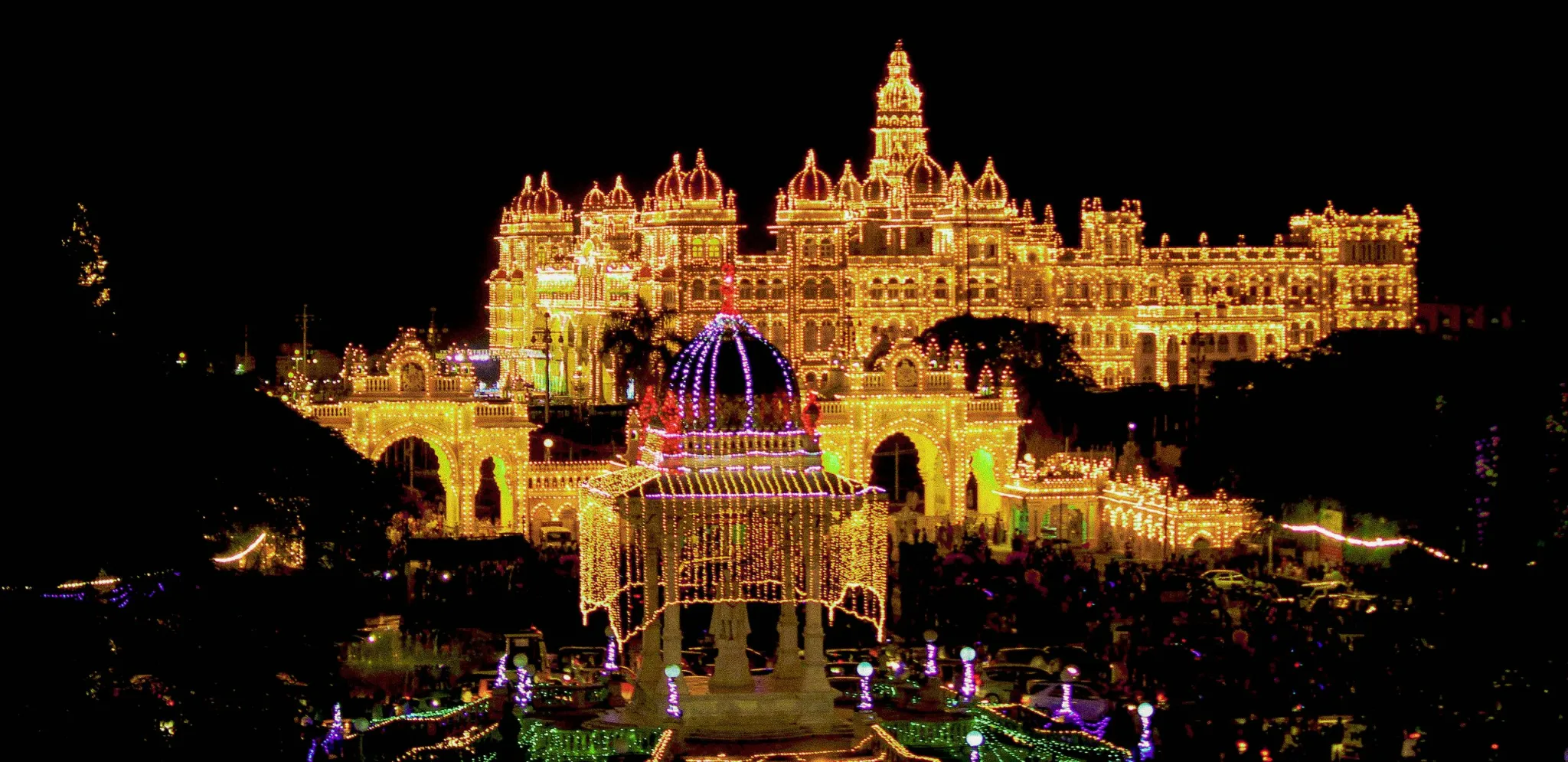
Dussehra, celebrated as Vijayadashami in Mysore, is deeply rooted in the city’s mythology. The festival commemorates the victory of Goddess Chamundeshwari over the demon Mahishasura. This event is so integral to the city’s identity that its very name, Mysore, is derived from “Mahishasura.” The tale symbolizes the triumph of good over evil, and celebrations in Mysore during Dussehra are a testament to this age-old narrative.
Celebrations in the time of Vijayanagara
The Mysore Dasara festival, while spiritual in its inception, began to take on a more cultural and artistic dimension during the Vijayanagara era. From 1136 to 1565 AD, the Vijayanagara kings, recognizing the importance of art and culture, provided royal patronage to the festival. This support transformed Dasara from a purely religious event to a grand celebration of the kingdom’s art, culture, and heritage.

The Wadiyars’ era
The Wadiyars of Mysore, once subjects of the Vijayanagara Empire, declared their independence in the late 16th century. Despite this political shift, they continued to honour the Dasara traditions, even elevating their royal significance. The first grand celebration under their rule was in 1610 in Srirangapatna. Their commitment to the festival was so profound that it persisted even during the reigns of rulers like Hyder Ali, who was not originally from the Wadiyar lineage.
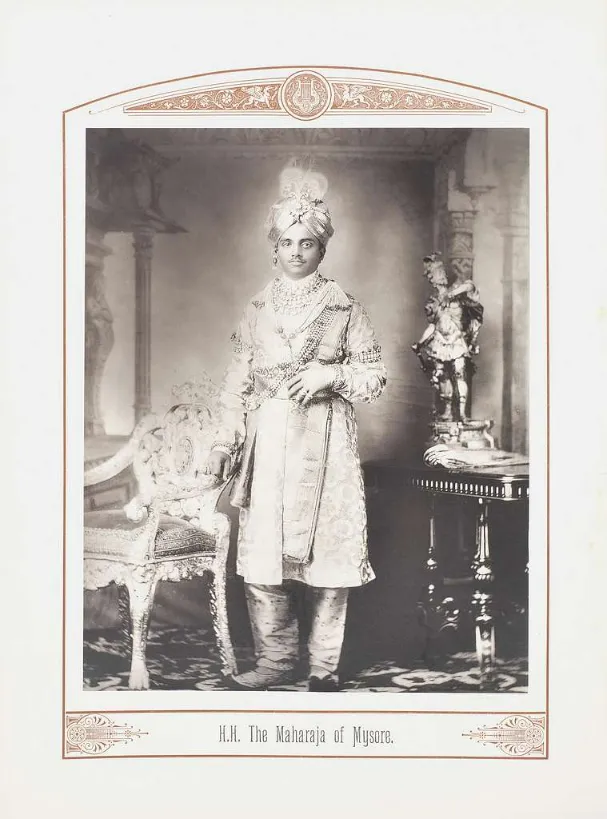
Dasara under the reign of Hyder Ali
Hyder Ali, though a different ruler with a distinct leadership style, continued to uphold the grandeur of the Dasara festivities. He hosted a 10-day banquet, invited state dignitaries, and indulged in various entertainments. From fireworks to animal fights and wrestling matches, the celebrations under Hyder Ali were a blend of tradition and personal tastes. The ‘Ghirbul’, a circular enclosure for wrestling, and the chained tiger spectacle, were among the unique additions during his reign.
Tipu Sultan’s influence on Mysore’s Dasara
Tipu Sultan, succeeding Hyder Ali, ensured that the essence of the Dasara festival remained untouched. James Scurry’s accounts provide a vivid description of the celebrations. The festival under Tipu was reminiscent of the ancient Olympic games, with various contests spanning over ten days. From rams battling each other to wrestling matches between renowned schools, the festivities were a blend of tradition and spectacle.
Colonial imprints on Mysore Dasara festivities
The British era brought about significant modifications to the Dasara celebrations. After their victory over Tipu Sultan, they reinstated Mummadi Krishnaraja Wadiyar III to the throne in 1799. The festival then saw the introduction of the durbar, a concept borrowed from the Mughal Empire.
However, it was during the reign of Nalwadi Krishnaraja Wadiyar IV that the festival reached unparalleled grandeur. The procession, with the king atop a decorated elephant in a golden carriage, became emblematic of Mysore’s Dasara. Although the festival’s splendor diminished slightly after India’s independence, it has since regained its glory, drawing tourists from all over the world to witness Mysore’s magnificent Dasara celebrations.
Regal rituals and traditions of Mysore Dasara
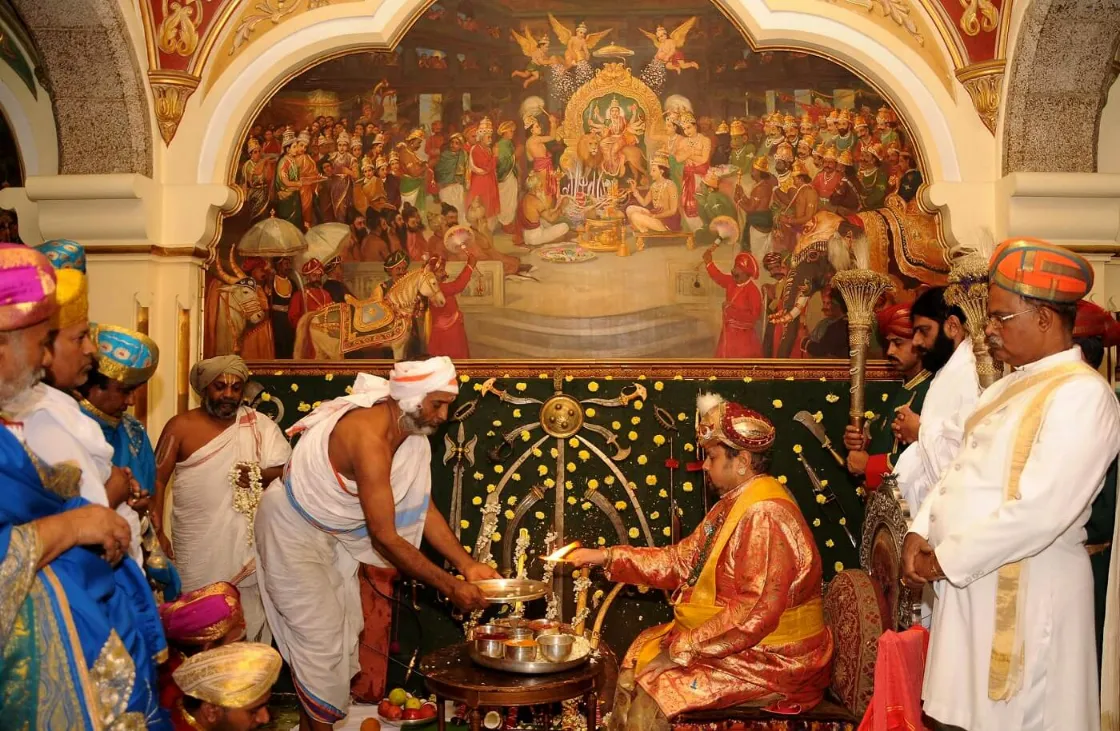
As I stood amidst the vibrant festivities of Dasara, a wave of amazement washed over me. I realized that Dasara wasn’t just a religious celebration but also a martial one. Click here to understand the diverse ways Dussehra is celebrated across India, including the traditions of Mysore. The essence of Vijayadashami, marking the triumph of good over evil, resonated deeply with stories from both the Ramayana and Mahabharata. I recalled the tale of Lord Rama returning home victoriously from Sri Lanka on this very day. Similarly, in the Mahabharata, Arjuna chose this day to retrieve his concealed weapons from the Banni tree after the Pandavas’ exile. Watching the procession culminate at the Banni Mantapa, I couldn’t help but connect the dots. It dawned on me that the Mysore kings, recognizing the day’s auspiciousness, often commenced their war campaigns after nine days of devout worship.
The ceremonial bath
The Mysore Dasara festival commences with a ceremonial bath for the king. This isn’t just a mere ritual but a profound act of purification. The bath signifies the king’s spiritual preparation for the days of devout worship that lie ahead. It’s a symbolic gesture, representing the cleansing of the mind and soul, ensuring that the king is in the purest state to lead the festivities and rituals associated with Dasara.
The sacred band
Post the ceremonial bath, a sacred band, often intricately designed and embedded with religious symbols, is tied around the king’s wrist. This act is not just a tradition but a protective charm, believed to shield the king from any harm and ensure the smooth progression of the festival. The very act of tying the band fills the atmosphere with a palpable sense of anticipation, marking the beginning of the grand celebrations.
The royal durbar
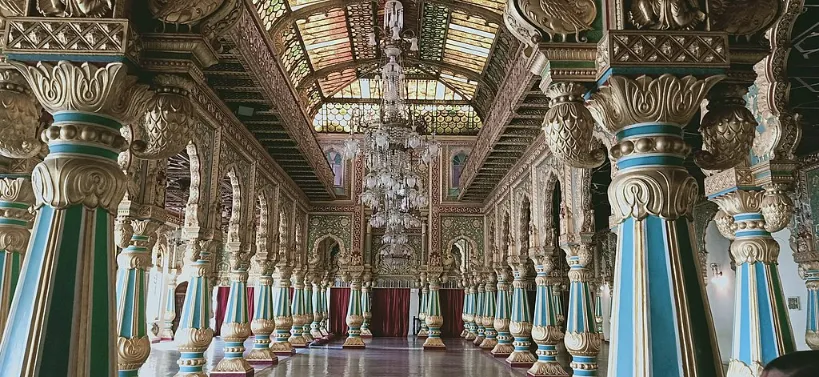
As I ventured into the palace grounds, I was immediately drawn to the Durbar Hall. The Golden Throne, a symbol of the Wadiyar dynasty’s legacy, was displayed in all its splendour. I had heard that this throne was only unveiled for the ten days of Dasara, making it a rare sight. Explore the intricacies and wonders of Mysore Palace with this in-depth guide, offering a deep dive into its history, architecture, and the stories that make it a must-visit destination. The intricate carvings and the shimmering gold left me in awe. I felt a deep sense of reverence, thinking about the generations of kings who had sat on this very throne. The ceremonial durbar is marked by a royal march, where courtiers, musicians, and dancers pay homage to the king. The palace’s corridors echo with songs extolling the king’s virtues.
While I couldn’t attend the private darbar, whispers of its grandeur reached my ears. I imagined the king, standing tall and proud, before taking his seat on the throne, all to the harmonious tunes of the Palace anthem ‘Kayo Sri Gauri.’ The exclusivity of the event, with only a few select individuals and media persons allowed, added to its mystique. I could only dream of the opulence and tradition that unfolded behind those closed doors.

Worship of the Navagrahas and Throne
The festival’s spiritual essence is further emphasized as various sacred elements within the palace are venerated. The Navagrahas, representing the nine celestial deities, the kalasha, a sacred pot symbolizing abundance, and the royal throne, a symbol of the king’s authority, are all worshipped. Each day, the palace resonates with melodious chants and hymns dedicated to Goddess Chamundeshwari, creating an ethereal atmosphere of devotion. Click here to read how Goddess Chamundeshwari became a synonym for women’s empowerment.
The illumination of Mysore Palace
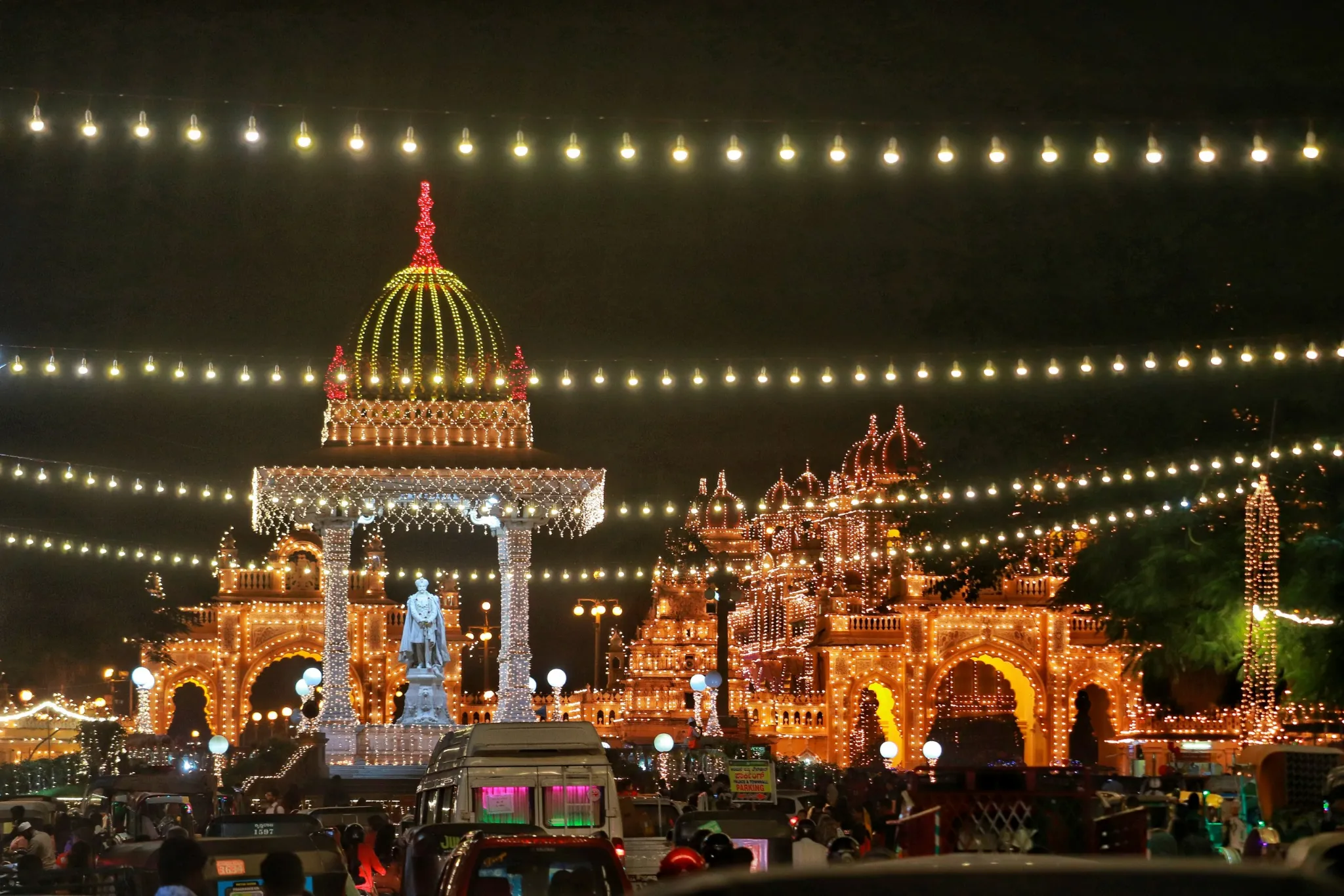
As dusk settled, the Mysore Palace transformed into a radiant spectacle. The countless lights adorning the palace made it look like a jewel glistening under the night sky. The highlight of the ten-day Mysore Dasara festival is the daily illumination of the Mysore Palace, adorned with approximately 100,000 light bulbs, from 7 pm to 10 pm throughout the festival. The festival features a diverse range of cultural and religious performances that showcase the dance, music, and rich culture of Karnataka, all taking place in the magnificent backdrop of the illuminated Palace.
Every archway, every corridor, every turret was bathed in a golden glow. The reflection of the lights in the surrounding waters added to the ethereal beauty. I stood there, captivated, feeling as if I was in a fairy tale. The sheer magnificence of the illuminated palace made me realize the grandeur of the Mysore Dasara. If you are planning an unforgettable road trip this Dussehra season, check out this essential guide.
The Royal Procession (Jamboo Savari/ Jamboo Savari)
The pinnacle of the Dasara celebrations was the day of Vijayadashami. As I stood among the throngs of people, the sight of the king participating in the Jamboo Savari was a spectacle to behold. This was no ordinary procession; it was a grand parade that beautifully captured the essence of Mysore’s illustrious heritage.
The procession’s name has an intriguing history. Originally termed “Jambi Savari,” it was named after the Banni (Shami) tree located on the city’s outskirts. Mythology narrates that the Pandavas hid their weapons in the Banni tree during their exile. Before embarking on battles, kings would worship this tree, seeking victory. However, during the colonial era, the British renamed it “Jamboo Savari,” a name that has since remained.
Torch Light Parade
The Torchlight Parade at Bannimantap is a highlight of the Dasara festivities, eagerly awaited by both tourists and Mysuru’s residents. As I learned, preparations for this grand finale were extensive, with 300 police personnel gearing up to participate. The parade showcased various drills, with officers holding burning torches, known as “Deevatige” or “Punju” in Kannada. These torches, reminiscent of times when elephants and cultural artists returned to the palace post-procession, are made of brass with wooden handles. The torches’ containers are filled with cotton seeds, and the cotton cloth covering them is soaked in kerosene and oil, ensuring a prolonged, bright flame. This parade, initially a display of the state’s military strength, now serves as a window into Mysore’s storied past.
Cultural tapestry – Daily artistic showcases during Dasara
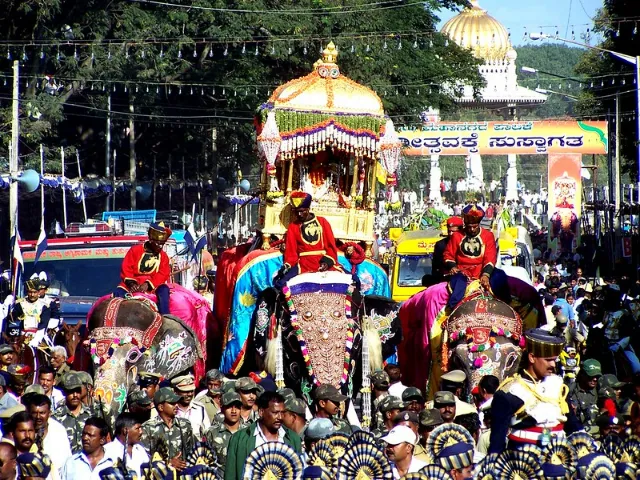
Among the many wonders of Mysore Dasara, the performing arts held a special place in my heart. Standing before the majestic Mysore Palace, bathed in the glow of countless lights, I felt as if I was in a dream. The palace, with its radiant illumination, seemed to come alive, setting the perfect stage for India’s finest artists. Every evening, the melodies of classical music enveloped the surroundings, drawing in large crowds.
The harmonious blend of rhythmic beats and the elegance of classical dance performances left me, and many others, spellbound. Yet, the artistic celebrations weren’t limited to the palace alone. Other venues, such as the Jaganmohan Palace, Town Hall, Veena Sheshanna Bhavan, and Kalamandir, were buzzing with cultural fervor. I found myself drawn to a myriad of performances, from the storytelling art of Harikathe to the rhythmic Kamsale Pada, the narrative Gamaka, the theatrical Yakshagana, which you can read all about here, and the magical puppet shows.
Attractions along Mysore’s Dasara path
- Wrestling Tournament: Wrestling, a sport deeply rooted in Indian tradition, takes center stage at this tournament. Wrestlers from various parts of India converge at the Devraj Urs stadium to showcase their prowess and compete for the title. The event is not just about the sport but also about the cultural significance it holds. The energy, the traditional rituals, and the sheer physicality of the sport make it a spectacle, drawing a vast audience both locally and from other parts of the country.
- Location: Devraj Urs stadium.
- Mysore Dasara Flower Show: A visual treat for nature lovers, the Mysore Dasara Flower Show is a grand display of horticultural excellence. With a vast collection of flowering plants, the show is a riot of colors and fragrances. From exotic species to local favorites, the flower show is a testament to the region’s rich biodiversity. Tourists and locals alike flock to the park to witness this botanical marvel, making it one of the festival’s main attractions.
- Location: Nishad Bhag or Kuppanna Park.
- Cannon Firing: The Cannon Firing is a majestic 21-gun salute, a tradition to honor the Chief Guest of the festival. This ceremonial event is not just about the salute but is also accompanied by the grandeur of the Jamboo Savari, music bands, and dance groups. The combined effect of the cannon’s roar and the cultural performances creates a unique and unforgettable experience for the attendees.
- Drama Festival at Rangayana: Theatre has always been a medium to reflect society, its issues, and its culture. The Drama Festival at Rangayana is a celebration of this art form. With plays from various genres and themes, the festival offers a platform for artists to showcase their talent and for audiences to engage in thought-provoking performances. It’s a confluence of creativity, culture, and conversation.
- Location: Rangayana Theatre.
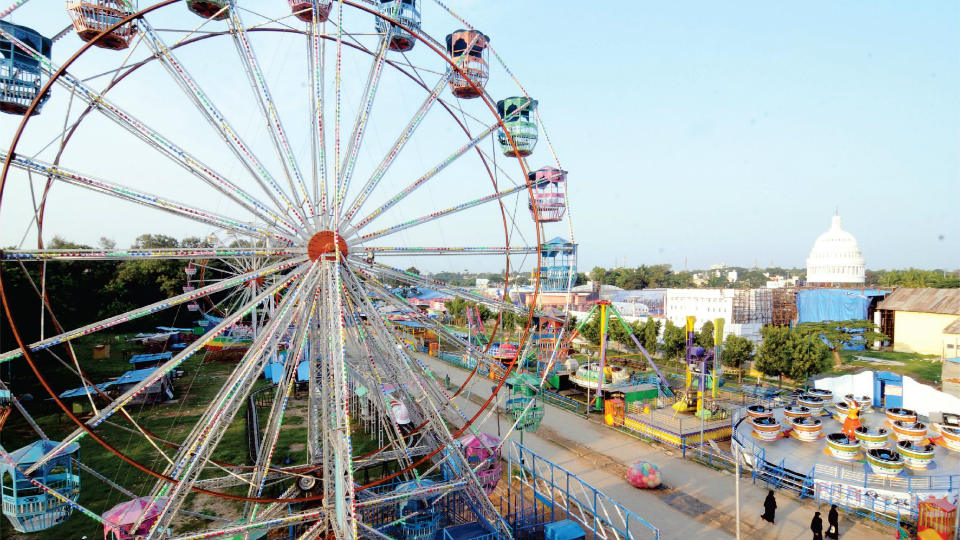
- Dasara Exhibition: The Dasara Exhibition is a microcosm of the festival’s spirit. It’s a bustling space filled with stalls from various government departments, commercial vendors selling a myriad of products, and entertainment zones. Whether you’re looking to understand Karnataka’s initiatives, buy souvenirs, or simply enjoy a Ferris wheel ride, the exhibition has something for everyone. It’s a blend of tradition and modernity, making it a must-visit spot during the festival.
- Location: Doddakere Maidan, opposite the Mysore Palace
- Culinary Delights: No festival is complete without its array of delicious foods, and Mysuru Dasara is no exception. The festival offers a smorgasbord of mouthwatering delicacies, ranging from traditional Karnataka dishes to popular Indian cuisines. For food, head to Sri Harsha Road, which has many restaurants. The restaurants in Hotel Viceroy and Hotel Parklane offer decent south Indian, north Indian and Chinese cuisines. The restaurant at Hotel Dasaprakash serves delicious South Indian thali. For desserts, look no further than Guru Sweets on Sayyaji Road, for the legendary Mysore pak, which the city is famous for.
A standout moment for me was the 9-day drama festival at Rangayana. Each play I witnessed spoke volumes of the region’s rich theatrical heritage. There are also workshops, seminars, talks and lectures, food fests and handicraft expos which are held on the sidelines of these fests. The combination of music, dance, and drama during the Mysore Dasara was a feast for the senses, making it an unforgettable experience. Mysore Dasara will be celebrated between the 3rd of October and 12 October 2024.
Here’s a list of events that will be taking place in 2024.
Mysore Dasara 2024 – Schedule and highlights
| Date | Time | Event |
| 03 Oct 2024 | Morning | Inauguration with Pooja to Goddess Sri Chamundeshwari Devi at Sri Chamudeshwari Temple, Chamundi Hills |
| Evening | Cultural Programme Inauguration at Mysore Palace | |
| 04 Oct 2024 | 6 pm | CM Basavaraj Bonmai inaugurates Dasara Cultural events and presents “Rajya Sangeetha Vidwan’ Award |
| 7.30 pm | Dance feature ‘Karunada Vaibhava’ by Prabhat Kalav. idaru of Bengaluru. | |
| 05th Oct 2024 | 6 pm | ‘Janapada Kavya Gayana’ by Malavalli Mahadevaswamy and Appagere Thimmaraju. |
| 7 pm | Violin recital by Hosahalli K Venkataramu, Shivamogga. | |
| 9 pm | ‘Kannada Dimdima’ by Y.K Muddukrishna and troupe | |
| 06 Oct 2024 | 6 pm | ‘Sangeeth Durbar’ by H.N. Bhaskar and troupe, Mysuru |
| 7 pm | ‘Nalwadi-Nalnudi Bhaava Sambhrama’ by Hamsalekha and troupe, Bengaluru. | |
| 07 Oct 2024 | 6 am to 6 pm | Dawn-to-Dusk special programmes. |
| 6 pm | Prog by Amogha Varsha Drums Collective, Bengaluru. | |
| 6.45 pm | Ghazal by Shantala Vattam and troupe, Mysuru. | |
| 7.30 pm | ‘Madhura Madhuaravi Manjula Gaana’ by Shamitha Malnad and troupe, Bengaluru | |
| 08 Oct 2024 | 6 pm | Police Band |
| 7.30 pm | Dance feature by Shreya Prahlad Kulkami, Bagalkot. | |
| 8.15 pm | ‘Dasavani’ by Raichur Sheshagiri Das and troupe. | |
| 09 Oct 2024 | 6 pm | Suganar Sangeetha by Adithi Prahlad and troupe. |
| 7 pm | Hindustani Concert by Muddumohan and troupe. | |
| 8 pm | Flute Jugalbandi by Pt. Pravin Godichindi and his son Shadaj Godkhindi | |
| 10 Oct 2024 | 6 pm | Hindustani Concert by Pt. Jayathirtha Mevundi & troupe. |
| 7 pm | ‘Ranga Geethegalu’ by B. Jayashree & troupe, Bengaluru. | |
| 8.30 pm | Dance feature by Sridhar Jain & troupe, Mysuru. Online premièring of Maharaja Swathi Thirunal’s Navarathri Krithiset | |
| 11 Oct 2024 | All Day | Maha Navami – Ayudha Puja |
| 12 Oct 2024 | All Day | Vijaya Dashami / Jamboo Savari – Dasara Procession and Torch Light Parade |
Vijayadashami – The majestic climax of Mysore Dasara
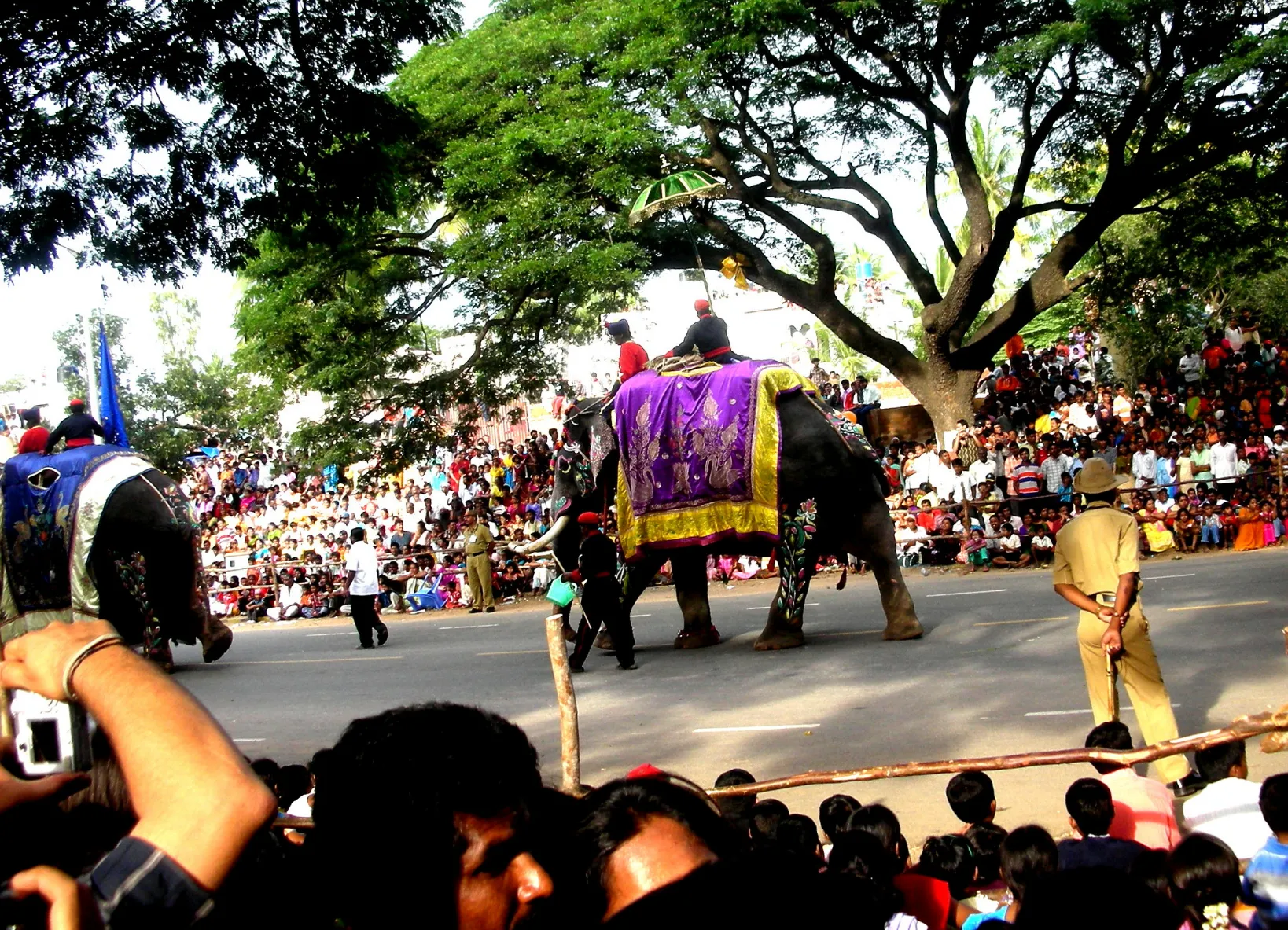
As the festival approached its climax, the anticipation for Vijayadashami was palpable. This day wasn’t just the end of Dasara; it was the embodiment of the festival’s spirit, celebrating the victory of good over evil. Outside the palace and all along the parade route, I’m struck by how densely packed the crowd is. Everywhere I look, there are barriers trying to manage the throngs of people, but they’re spilling onto roads, trees, rooftops, and any available spot. It’s their unwavering dedication that truly fuels this festival. Many have journeyed from neighboring areas, and I can see they’re prepared to brave any weather just for a brief chance to offer their prayers to the deity making its way through the city.
From dawn, people gathered, many foregoing their meals, all eagerly awaiting the grand Jamboo Savari. The significance of this day was evident in the collective energy of the crowd. The Jamboo Savari, I learn, begins right here at the palace. Within its walls, there’s a temple where a special ceremony is held. Each year, fresh themes are introduced, adding layers of depth and meaning to the parade. The spectacle left me spellbound.
The air vibrates with the sound of cannons as the parade unfolds. Elephants, dancers, musicians, various animals, vintage cars, and vibrant floats begin their slow procession from the palace gates into the heart of Mysore’s streets. The parade’s pace is leisurely, and I estimate it’ll take about three hours to complete the 4.5km journey to the Banni Mantap grounds. The parade route, stretching from Mysuru Palace through Sayyaji Rao Road, Albert Victor Road, Nelson Mandela Road, and culminating at Bannimantap, was lined with spectators. Given that it’s Mysore, each of these routes boasts unique attractions and activities. I highly recommend saving this Mysore travel guide for top recommendations on what to do.
The entire route is a spectacle, with ropes marking boundaries and people squeezed in on both sides. With the guidance of my Savaari driver, I found a prime spot to witness the procession. Furthermore, the musical cadences of the State Police bands provide a rhythmic backdrop to the procession, enhancing its grandeur. Once it concludes, the governor and a member of the Wodeyar royal lineage step up to kick off the parade, right around 2:00 p.m. They ascend a stage and pay their respects to the idol of Chamundeshwari. My attention is then drawn to Abhimanyu, the lead elephant for the day, adorned in a tapestry of brilliant blues, yellows, and magentas.
The moment the first of the 12 elephants, including the renowned Abhimanyu, appeared, my heart raced with excitement. The elephants, with their vibrant drapes and gold ornaments, were a testament to Mysore’s rich history. Among them were the famed tuskers like Arjuna, Bhima, Mahendra, Dhananjaya, Gopi, and Parthasarathy, each having undergone months of meticulous preparation for this day. As the parade progressed, troupes of folk dancers, musicians, and tableaux brought to life Karnataka’s tales, legends, and cultural heritage. Yet, the pinnacle of the procession was the sight of Goddess Chamundeshwari, dazzling in a golden howdah atop the lead elephant. Her presence was a radiant reminder of the triumph of righteousness.
The Golden Howdah weighs 750 Kilograms in weight and is purely made of gold! As I weaved through the crowd, it became clear to me that the true spirit of this celebration lies in the hearts of the spectators as their energy and enthusiasm breathe life into the performers. As the day’s festivities at the former concluded, the city’s energy shifted, drawing everyone’s attention to the latter. The anticipation was palpable, and as the sun set, the gleaming torches at Bannimantap promised a continuation of the day’s splendor, bridging the gap between the city’s rich history and its regal present.
Bannimantap – The gleaming torch light parade
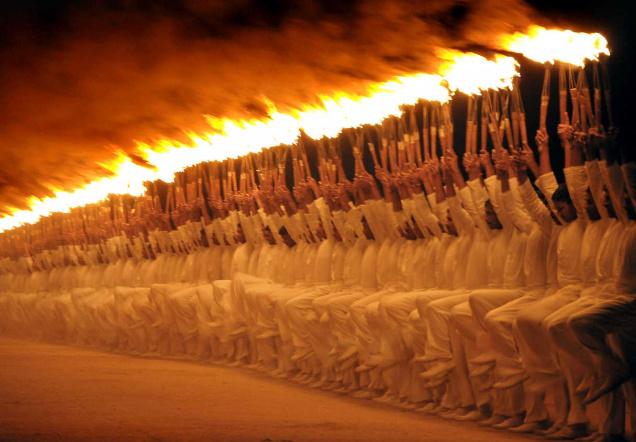
The festivities didn’t end with the Jamboo Savari. At the Bannimantap Parade Grounds, the Torch Light Parade added another layer of grandeur. The sight of the Maharaja, donning his royal riding attire and entering the parade grounds on horseback, was awe-inspiring. As he received salutes from his military units, the grounds lit up, echoing the splendor of Mysore’s bygone era. This parade, once a display of military might, now stood as a testament to the state’s glorious past.
The spectacle was further enhanced by equestrian displays, thrilling motorbike acrobatics, and a mesmerizing laser show. As the evening drew to a close, the national anthem of the erstwhile Mysore state, played by the military band, resonated in the air. Standing there, I felt a deep connection to Mysore’s history and traditions, an experience forever etched in my memory.
Why witness Mysore Dasara with Savaari?
Experiencing Mysore Dasara was nothing short of magical. The vibrant colours, the rhythmic beats of the drums, the majestic elephants, and the sheer energy of the crowd – it was a sensory overload in the best way possible. But what truly elevated my experience was my decision to book a Savaari for the trip.

Navigating through the bustling streets of Mysore during Dasara can be quite a challenge. The city, brimming with eager spectators, becomes a maze of excitement and anticipation. But with Savaari, I didn’t have to worry about getting lost in the crowd or missing out on any of the festivities. With Savaari’s car rental services in Mysore, I didn’t have to worry about getting lost in the crowd or missing out on any of the festivities. The expertise of my Savaari chauffeur, who knew the city like the back of his hand, ensured that I was always in the right place at the right time.
Thanks to my Savaari driver’s local knowledge, I secured a prime spot to soak in the grandeur of the Jamboo Savari. But the highlight? It was when my driver, understanding my fascination with the elephants, guided me to a location where I could interact with the majestic gentle giant Abhimanyu and Arjuna. That moment, being up close with these magnificent creatures, was surreal and something I’ll cherish forever.
Booking with Savaari was more than just hiring a cab; it was like having a local friend guiding me through the festivities, ensuring I had the most authentic and memorable experience. If you’re considering a trip to Mysore for Dasara, I can’t recommend Savaari enough. Simply download the Savaari app, and a royal Mysore experience awaits you. With the convenience, local insights, and unparalleled service they offer, your Dasara experience will be transformed from memorable to unforgettable.
Last Updated on December 17, 2024 by Shabari Shankar



